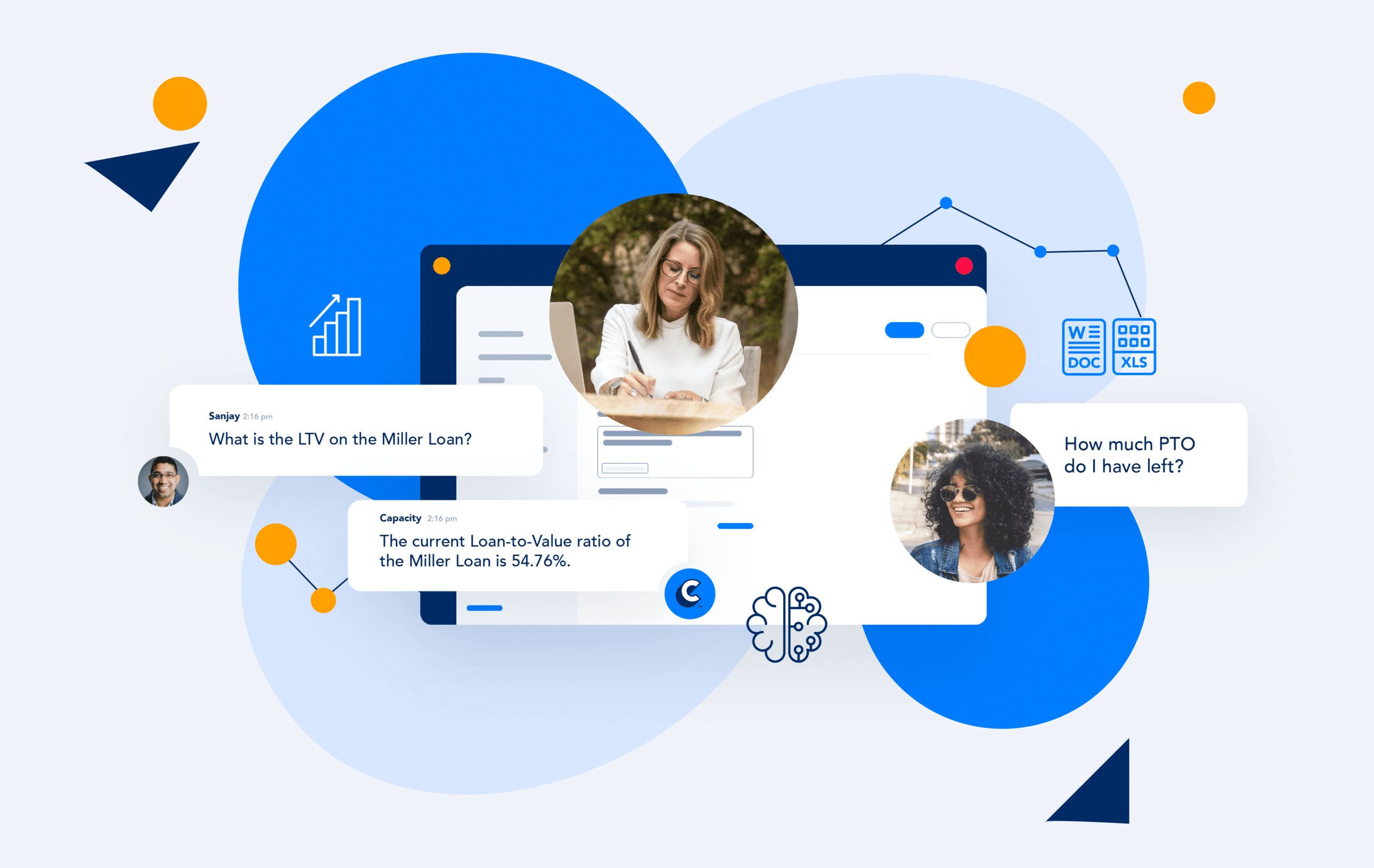During HousingWire’s third annual Engage Marketing Summit, our CEO, David Karandish, gave a live demo that featured how our platform can help marketing professionals in the mortgage industry. We’re breaking down that demo into a few brief sections that focus on how Capacity benefits external and internal users, how the back-end works when Capacity doesn’t know an answer, and how all the features work together. If that’s not enough information, and you’re interested in seeing the demo in full, head over to our resource library!
Benefits for external users.
For customers who are visiting your website, David first demonstrated how Capacity acts as a web concierge to provide instant answers to questions that your team would normally answer via phone calls, emails, or tickets. By placing a conversational AI chatbot on your website, your team can focus on higher-value tasks, and reap the benefits of the following features.
- White labeling:
Capacity enables any company to white label our bot to fit brand colors and personality.
- Auto-filling questions for instant and accurate answers:
Whenever a user visits a website with Capacity’s web concierge, they can ask questions. As the user types, Capacity will show options of the different questions that it knows how to answer to save the user time. Once the question is submitted, Capacity comes back with a response that could include an answer and/or a link to the page where the information can be found.
- Feedback:
Once the question is answered, the user can give the answer a thumbs up or thumbs down, which is enabled by Capacity’s machine learning. If the thumbs-up is hit, Capacity will understand that the answer was an accurate response. If the thumbs-down was hit, Capacity will bring in a human-in-the-loop to create a more accurate response that it will learn to use the next time a similar question is asked (more on that later).
- Clarifiers:
If a user asks a question with a misspelled word, Capacity’s built-in natural language processing (NLP) provides a few options of what it thinks the user is asking based on context clues.
- Easy definitions:
If an answer that Capacity provides has an acronym that the user doesn’t know, they can also ask Capacity what it means and receive an instant definition. The same goes for all of the forms. If a user simply wants to know what a form is, such as a HUD-1 form, they can ask Capacity and receive an instant response.
Internal user benefits.
Next, David covered the benefits that your internal team members can experience with Capacity. Just like your customers, your team needs access to information too, but they often have to search through email threads, internal documents, and intranets to find it. Rather than making them waste time searching, Capacity enables your team with a few tools that help them access the information they need when they need it.
Co-Pilot Console:
For internal users, they can simply open the Co-Pilot Console (or a collaboration tool, such as Slack or Teams) and ask Capacity their questions for instant answers. Whether your employees are asking questions for themselves (such as, “how do I order business cards?” and “how do I reach Broker Services?”) or for the customer (like, “does every applicant have to complete the Covid-19 Borrower Certificate?”), Capacity can help lead them in the right direction without getting another teammate involved.
Developer Platform:
Team members frequently search through applications for imperative information to do their jobs. Rather than making your team lose concentration and time by logging in and out of apps, Capacity integrates with:
- Team-specific tools like Salesforce and Hubspot so the Marketing and Sales team can receive information on leads without logging in.
- Your email and calendar, so you can set meetings with your teammates without searching for availability, and send emails without opening up a new tab.
- Vertical-specific apps such as Ellie Mae, AllRegs, and Encompass so loan officers and underwriting desks can gain instant access to guidelines, updates on loans, and more without logging in and searching for it.
What happens if the bot doesn’t know the answer?
Capacity accurately answers an average of 84% of the questions it’s asked. However, the remaining 16% of the questions that Capacity doesn’t know are seamlessly escalated to level 1 support.
Helpdesk:
Capacity will give users the option to file a ticket when it doesn’t know the answer, so the question will seamlessly get handed off to someone who can provide an accurate response. Once a user selects “file a ticket,” Capacity will collect their email address, and notify your support team that an unanswered question has just been asked.
From the helpdesk, your team member responsible for responding will get to work to answer this question by updating the status of the ticket to “in progress” and deciding to either create a new exchange by adding a new answer to the question or map the question to a current answer that already exists. Depending on the nature of the question, the team member can set an expiration date on the answer, so users never get stale information. Finally, the user who filed a ticket will get an update that the answer to their question is now available.
How does it all fit together?
Capacity takes offline processes and digitizes the steps, which enables users to assign steps to one another and the Capacity bot. During the demo, David shares the functionality of the workflows and breaks down an example of how Capacity can automate the loan origination process. Jump to minute 16:35 in the video to see exactly what we’re referring to.











































